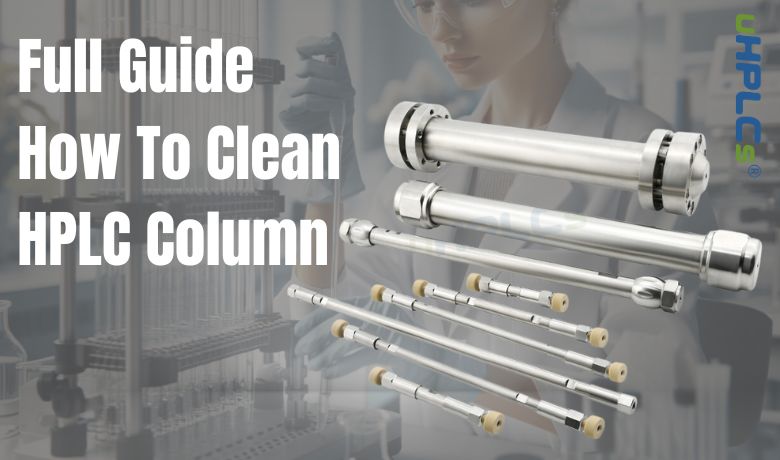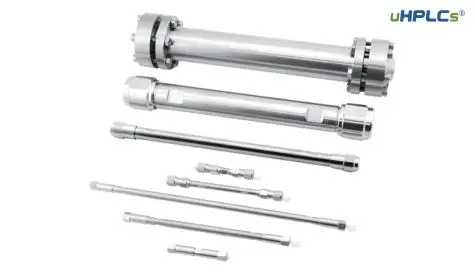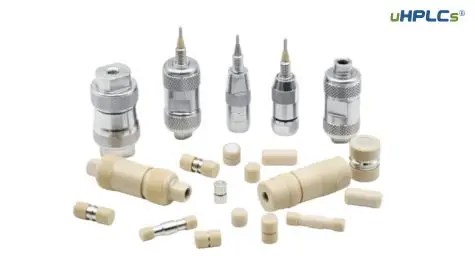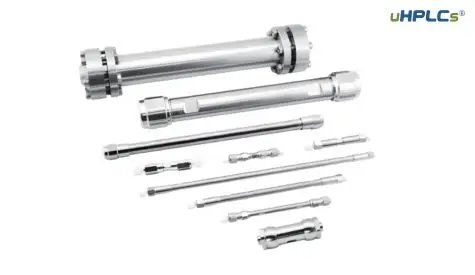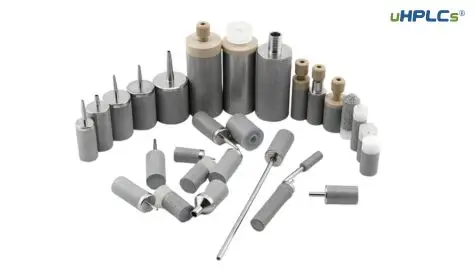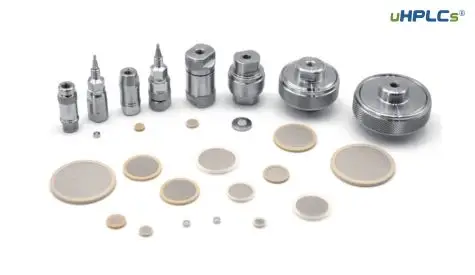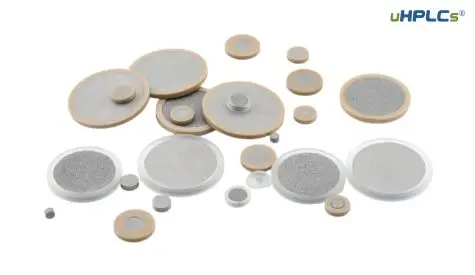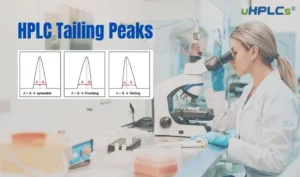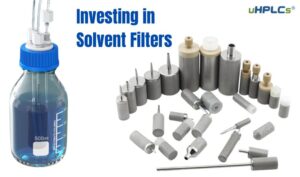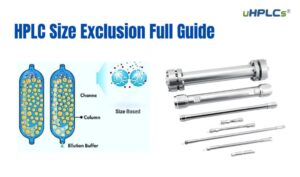High-Performance Liquid Chromatography (HPLC) columns are the workhorses of analytical chemistry, separating complex mixtures into their individual components. However, like any high-precision instrument, proper maintenance is crucial for ensuring optimal performance and longevity.
Why we like to Clean HPLC Columns ?
Regular cleaning of HPLC columns is essential for two key reasons:
Extending Column Life: Over time, sample components can adhere to the stationary phase inside the column, reducing its efficiency and ultimately leading to inaccurate results. By routinely cleaning the column, you remove these contaminants, preventing them from accumulating and causing permanent damage.
Maintaining Analytical Accuracy: Contaminated columns can exhibit phenomena like peak broadening and ghost peaks, compromising the separation and identification of analytes. Consistent cleaning helps maintain the integrity of the stationary phase, ensuring sharp peaks and reliable data.
Therefore, incorporating proper cleaning procedures into your HPLC workflow is vital for both preserving your valuable columns and guaranteeing the accuracy of your analyses.
Part 1: Understanding HPLC Column Maintenance
An HPLC column is a marvel of miniaturized engineering, separating intricate mixtures based on subtle interactions between the sample and the stationary phase.
Understanding the column’s components is crucial for appreciating the importance of maintenance:
- Stainless Steel Tubing: Encases the stationary phase, providing a high-pressure environment for the mobile phase to flow through.
- Stationary Phase: The heart of the column, typically a silica-based packing material chemically modified to exhibit specific separation properties (e.g., reversed-phase, ion-exchange).
- Frits: Fine filters at the inlet and outlet of the column prevent particulates from entering the stationary phase and causing blockages.
Routine maintenance safeguards these components from detrimental factors:
- Contamination: Sample components can strongly adhere to the stationary phase, hindering its ability to interact with subsequent samples. This reduces column efficiency and leads to peak broadening, affecting the separation and quantification of analytes.
- Degradation: Over time, exposure to harsh solvents, high pressure, and extreme temperatures can weaken the stationary phase and alter its chemical properties. This results in loss of column resolution and inaccurate peak identification.
By implementing a regular cleaning regimen, you can:
- Eliminate residual sample components that could potentially contaminate future analyses.
- Minimize exposure to harsh conditions that may degrade the stationary phase.
Therefore, proper maintenance becomes an investment in the longevity and performance of your HPLC column.
Part 2: Signs Your HPLC Column Needs Cleaning
Just like a car engine warning light, your HPLC column can exhibit certain symptoms that signal the need for cleaning. By recognizing these signs, you can take preventive measures and ensure the continued accuracy and efficiency of your analyses.
Here are some telltale signs that your HPLC column might be harboring unwanted guests:
- Increased Backpressure: This occurs when contaminants accumulate within the column, hindering the flow of the mobile phase. A significant and unexplained rise in backpressure is a strong indication that cleaning is necessary.
- Decreased Resolution: The column’s ability to separate closely eluting peaks is a crucial performance metric. If you observe a reduction in the separation between peaks (especially critical pairs), it suggests that contaminants might be interfering with the interaction between the analytes and the stationary phase.
- Changes in Retention Times: The time it takes for a particular component to travel through the column and be detected is characteristic. A noticeable shift in retention times for known standards can signify that the column’s chemistry has been altered by contaminants, requiring cleaning.
Diagnosing these issues often involves a combination of observations:
- Monitoring backpressure trends over time.
- Evaluating peak shapes for signs of broadening or tailing.
- Comparing retention times of standard injections with historical data.
Additional factors to consider:
- Sample matrix complexity: Samples with high amounts of non-analytes are more likely to foul the column.
- Mobile phase composition: Certain solvents can be harsher on the stationary phase, necessitating more frequent cleaning.
By being attentive to these signs and understanding the underlying causes, you can effectively diagnose the need for column cleaning and take timely action to maintain optimal performance. Remember, early intervention is key to preserving the lifetime and analytical integrity of your valuable HPLC column.
Part 3: General HPLC Column Washing Techniques
Regular cleaning is vital for maintaining the health of your HPLC column. Here’s an overview of the general procedures involved:
Basic Washing Protocol:
- Mobile Phase Wash: Following each analysis, flush the column with the mobile phase used for the separation for a specified time (typically 10-15 minutes) at a moderate flow rate. This removes any residual sample components that might not have been completely eluted.
- Solvent Wash: Depending on the nature of the mobile phase and the anticipated contaminants, a stronger solvent like water/acetonitrile mixtures (varying ratios) can be used to further remove impurities. The specific solvent choice and duration of washing will depend on the column type and the suspected contaminants.
Addressing Different Contaminants:
- Organic Contaminants: These are often removed using organic solvents like methanol, acetonitrile, or isopropanol. The polarity of the solvent should be chosen based on the specific contaminant’s properties.
- Inorganic Contaminants: Buffer salts and other ionic species can be flushed out with water or dilute aqueous solutions of acids or bases (depending on the charge of the contaminant).
Important Considerations:
- Flow Rate: Maintain a moderate flow rate during cleaning to avoid disturbing the column packing.
- Volume: Use a sufficient volume of solvent (often exceeding 10 column volumes) to ensure thorough cleaning.
- Column equilibration: After cleaning, always re-equilibrate the column with the starting mobile phase composition before running further analyses.
Remember: Consult the manufacturer’s instructions and application notes for specific recommendations regarding cleaning procedures and solvents suitable for your HPLC column.
Additionally:
- Advanced Cleaning Techniques: In situations where severe contamination is suspected or basic washing fails, more advanced techniques like backflushing or the use of specialized cleaning solutions might be necessary. These techniques should only be attempted with proper training and following the manufacturer’s guidelines to avoid damaging the column.
By implementing these general cleaning procedures and tailoring them to the specific type of contamination encountered, you can effectively maintain the performance and longevity of your HPLC column.
Part 4: Advanced HPLC Column Washing Methods
While the basic washing procedures outlined previously are crucial for regular maintenance, certain situations demand a more robust approach. Here’s a glimpse into some advanced cleaning methods:
1. Backflushing:
- Technique: Briefly reversing the flow direction of the mobile phase through the column.
- Purpose: Dislodges strongly bound contaminants trapped at the column inlet frit or within the stationary phase.
- Effectiveness: Useful for removing stubborn particulates or tightly bound sample components.
Precautions:
- Not suitable for all columns: Consult the manufacturer’s specifications, as certain stationary phases can be damaged by backflushing.
- Controlled flow rate: Use a lower flow rate than the normal operation to prevent bed disruption.
- Limited application: Not a routine cleaning method; reserve for situations where basic washing proves inadequate.
2. Ultrasonic Baths:
- Technique: Submerging the column in a solvent bath while applying ultrasonic waves.
- Purpose: The cavitation process generated by the ultrasonic waves can dislodge tightly adhered contaminants from the stationary phase.
Limitations:
- Potential for damage: Ultrasonic waves can disrupt the packing material if not used judiciously.
- Limited effectiveness: May not be suitable for all types of contaminants.
- Expert guidance recommended: This technique should only be attempted with proper training and under the supervision of an experienced user.
3. High-Temperature Washing:
- Technique: Elevating the temperature of the washing solvent.
- Purpose: Certain contaminants with high thermal stability might require higher temperatures for effective removal.
Precautions:
- Temperature limitations: Exceeding the recommended temperature for the specific column can lead to permanent damage.
- Solvent selection: The chosen solvent must be compatible with the elevated temperature to avoid degradation.
- Expert consultation: Implementing this method requires a thorough understanding of the column chemistry and potential risks involved.
Remember:
- Advanced techniques should only be attempted as a last resort after exhausting other cleaning options.
- Always consult the manufacturer’s instructions and seek guidance from experienced personnel before employing these methods.
By understanding the capabilities and limitations of these advanced cleaning procedures, you can effectively address severe contamination issues while safeguarding the integrity of your valuable HPLC column.
Part 5: The "Magic Solution" for HPLC Column Washing
It’s important to address a crucial point: there isn’t a single “magic solution” that universally addresses all HPLC column cleaning needs.
While certain commercially available cleaning solutions or specific solvent mixtures might be effective for general cleaning purposes, their application heavily relies on several factors:
- Type of Column: Different stationary phases have varying tolerances towards solvents and cleaning procedures.
- Nature of Contamination: The effectiveness of a cleaning solution depends on the specific properties of the contaminants you aim to remove.
Therefore, relying solely on a pre-defined recipe can be detrimental to your column’s health.
However, some commonly used cleaning solutions include:
- Water/Acetonitrile mixtures: In varying ratios, effective for removing a broad range of non-ionic contaminants.
- Methanol: Suitable for removing hydrophobic organic compounds.
- Isopropanol: Another option for removing non-polar contaminants.
- Acidic or basic solutions: Used for removing ionic species like buffer salts, depending on their charge.
Important Safety Note:
- Always consult the manufacturer’s safety data sheets (SDS) for all chemicals used and strictly adhere to the recommended handling procedures.
- Working with organic solvents necessitates proper ventilation and personal protective equipment (PPE) like gloves, safety glasses, and a lab coat.
Instead of a universal recipe, a more prudent approach involves:
- Identifying the contaminant type: Analyze the suspected nature of the substances causing the performance issues (e.g., organic molecules, salts).
- Consulting the column manual and application notes: The manufacturer’s recommendations provide specific cleaning protocols and solvent compatibilities for your particular column.
- Starting with gentler cleaning methods: Begin with basic washing procedures and gradually progress towards stronger solvents or advanced techniques only if necessary.
By following this approach, you can ensure that the cleaning method employed is tailored to the specific needs of your column and minimizes the risk of potential damage.
Any, please Remember, prioritizing preventative maintenance through regular cleaning with appropriate solvents is the most effective strategy to prolong the lifespan and performance of your HPLC column.
Part 6: Waters HPLC Column Washing Procedure
Due to the specific nature of Waters HPLC columns and the potential for varying recommendations depending on the column type and application, it’s crucial to refer directly to the official Waters resources for the most accurate and up-to-date information regarding column washing procedures.
Here’s a recommended approach:
- Access the Waters Knowledge Base: Waters Corporation maintains a comprehensive knowledge base specifically dedicated to HPLC columns and troubleshooting. This resource provides detailed information on column care and cleaning procedures: https://www.waters.com/waters/support.htm?locale=r&cid=513773&lid=10008717
- Consult the Column Care & Use Manual: Waters provides specific care and use manuals for their various HPLC column models. These manuals outline the recommended cleaning solvents, flow rates, and other parameters specific to your column. You can typically find the manuals on the Waters website or by contacting their technical support.
- Waters Technical Support: For specific inquiries or if you require further guidance on the appropriate cleaning procedure for your Waters HPLC column, contacting Waters technical support directly is recommended. Their team of experts can provide tailored advice based on your specific column and situation.
Important Note:
- While this guide provides a general framework for accessing Waters’ recommended cleaning procedures, it’s crucial to prioritize information obtained directly from Waters Corporation to ensure the accuracy and safety of the cleaning process for your specific column.
Waters Cleaning Kits and Products:
Waters offers various cleaning kits and products designed to facilitate the maintenance of their HPLC columns. Information regarding their appropriate use can be found through the following resources:
- Waters website: The Waters website showcases their available products, including cleaning kits. You can search for specific cleaning kits based on your column model.
- Column Care & Use Manuals: As mentioned earlier, these manuals often provide recommendations for compatible cleaning kits and their usage.
- Waters Technical Support: For specific recommendations on the appropriate cleaning kits or products for your column, contacting Waters technical support is recommended.
By following these guidelines and prioritizing information directly from Waters Corporation, you can ensure that you have the most accurate and up-to-date recommendations for cleaning your Waters HPLC column.
Part 7: Tips for Extending HPLC Column Life
While proper cleaning is crucial, preventative measures play a vital role in prolonging the lifespan and performance of your HPLC column. Here are some key tips:
1. Sample Preparation:
- Filtration: Always pre-filter your samples through a membrane with a pore size appropriate for your column to remove particulate matter that can clog the frits and degrade the stationary phase.
- Centrifugation: This can further eliminate particulates that might have escaped filtration.
2. Mobile Phase Quality:
- Use high-purity solvents: Impurities in the mobile phase can interact with the stationary phase and compromise column performance. Opt for analytical or gradient grade solvents whenever possible.
- Filter the mobile phase: Even high-grade solvents can contain microscopic particles. Filter the mobile phase before use to minimize contamination.
3. Injection Volume:
- Minimize injection volume: Larger injection volumes introduce more sample components onto the column, increasing the workload and potential for contamination.
- Optimize injection volume based on your specific analysis requirements.
4. Gradient Optimization:
- Steeper gradients can be harsh: While they may offer faster analysis times, they can also put stress on the column.
- Use shallower gradients whenever possible to minimize the strain on the stationary phase.
5. Storage:
- When not in use: Store your column in the recommended solvent (often the initial mobile phase composition) to prevent the stationary phase from drying out.
- Seal the column ends: This prevents contamination from dust or airborne particles.
6. Handling:
- Avoid physical stress: Don’t drop the column or subject it to excessive vibrations.
- Follow proper installation procedures: Ensure the column is securely connected to the system to avoid leaks or damage.
Additional Tips:
- Monitor column performance: Regularly track backpressure, peak shapes, and retention times. Deviations from expected values can indicate potential issues requiring attention.
- Consult the manufacturer’s instructions: Each column type might have specific recommendations for optimal use and storage. Refer to the manufacturer’s guidelines for detailed information.
By implementing these preventative measures, you can significantly reduce the frequency of cleaning procedures and extend the lifetime of your valuable HPLC column. Remember, a well-maintained column translates to reliable data and cost-effective operation of your HPLC system.

